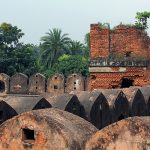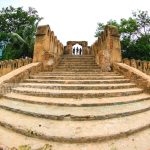The Dhaka Times Desk Hajiganj Fort is a water fort built during the Mughal period. It is located on the west bank of Shitalakshya river in Hajiganj area of Narayanganj district, Bangladesh. It is also known as Khizirpur Fort. This Hajiganj Fort is one of the three water forts built before the 17th century to protect the city of Dhaka in the triangle of water forts; probably immediately after the establishment of the Mughal capital at Dhaka by Mughal Subadar Islam Khan. The fort was built to ward off attacks by Mughal and Portuguese pirates along the river. The fort is located at a distance of 14.68 km from the capital Dhaka.
Hajiganj fort is one of the three water forts that were built before the seventeenth century to protect Dhaka city from external enemy attacks. The other two are Sonakanda Reservoir in Narayanganj and Idrakpur Reservoir in Munshiganj. Hajiganj fort is one of the most famous Mughal buildings. It is also known as Khizirpur Fort. According to most historians, this fort was built around 1650 during the reign of Subadar Mir Jumla of Bengal. Its location is near the west bank of Shitalakshya river in Hajiganj of Narayanganj district. After establishing the Mughal capital at Dhaka, the fort was built to resist the attacks of Mughal and Portuguese pirates on the river. Such forts are called Jaldurga because they were placed near the mouth of the river to keep an eye on the enemy traveling along the river and to ensure safety. From the beginning, the Subadars were thinking of ways to prevent pirate attacks. Subadar Mir Jumla consulted the engineers on a plan. The decision was to build a three-phase defense fort to keep Dhaka free from pirates.
The pirates' boats will come down the Meghna river and fall into the Dhaleswari estuary. Then it will enter Shitalaksya. Before that, cannon balls will be fired from Idrakpur to Dhaleswari estuary. Even then, if the pirate boats entered Shitalakshaya, cannon shots would be fired from the Sonakanda fort. And Hajiganj Fort will be the last resistance. If any boat comes forward avoiding the cannons of the first two forts, it will be caught by the cannon fire of Hajiganj fort. This is how Subadar Mir Jumla implemented the plan to build three forts.
This fort is quadrangular made of brick. The fort is surrounded by a wide wall. The fort walls have gun emplacements. The fort has special arrangements for firing cannons. The only entrance to the fort is on the north side. To enter this somewhat elevated fort, you have to climb about 20 steps of the entrance arch. And there are eight steps to descend from the archway to the fort square. Inside the wall there are walkways all around the wall.
In 1950, the fort was brought under the purview of the Directorate of Archeology and Museums. It has been renovated in various stages since then. However, at present, there is no initiative of the Directorate of Archeology regarding the Hajiganj water fort. The open field inside the fort is used by the local people as a pasture for cows and goats. And in the afternoon a historic place turns into a place where boys play football and cricket. On the left hand side of the entrance to the fort is a tall dilapidated building. The condition of this building is so bad that it may collapse anytime. This building was used as an observation tower to monitor the river course at that time.
The fort is about 250 meters long and 200 meters wide. The only entrance to the fort is on the north wall. The entrance is flanked by carved arches, the tops of which are decorated with lotus flowers. The walls of the fort's enclosing walls have fokars or holes, in which weapons can be stored. Round towers at four corners. There are stairs to climb to the top of the fort wall. The exterior of the turret also has a firing point. At one corner is a tall square pillar made of brick. Apart from this, there is a high altar for placing cannons. There is a walkway 1.22 meters above the base of the wall.
Day after day, year after year, the inside of this fort is gradually used as a pasture for domestic animals or a reliable place for children and teenagers to play. The jute warehouses on the Khas land on the way to the fort have lost their beauty since independence due to temporary leases. However, there are occasional reforms by the administration which are nothing to mention. And if it continues like this, after a few days it will seem like a fairy tale to the next generation.
How to go:
You can go to Narayanganj from Gulistan or Jatrabari by AC or non AC bus. The fare will be between 36 taka to 55 taka. And you can also go to Narayanganj by train from Kamalapur. Rent 15 to 20 taka. From Narayanganj bus or train station, take a rickshaw from Tk 15 to Tk 20 to go to Hajiganj fort.





